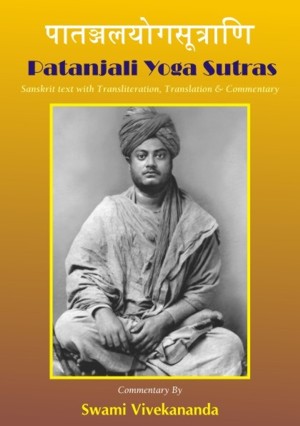40. परमाणु परममहत्त्वान्तोऽस्य वशीकारः ॥४०॥
paramāṇu parama-mahattva-anto-'sya vaśīkāraḥ ||40||
The Yogi’s mind thus meditating, becomes un-obstructed from the atomic to the Infinite.
The mind, by this practice, easily contemplates the most minute thing, as well as the biggest thing. Thus the mind waves become fainter.
41. क्षीणवृत्तेरभिजातस्येव मणेर्ग्रहीतृग्रहणग्राह्येषु तत्स्थतदञ्जनता समापत्तिः ॥४१॥
kṣīṇa-vṛtter-abhijātasy-eva maṇer-grahītṛ-grahaṇa-grāhyeṣu tatstha-tadañjanatā samāpattiḥ ||41||
The Yogi whose Vrttis have thus become powerless (controlled) obtains in the receiver, receiving, and received (the self, the mind and external objects), concentratedness and sameness, like the crystal (before different coloured objects.)
What results from this constant meditation? We must remember how in a previous aphorism Patanjali went into the various states of meditation, and how the first will be the gross, and the second the fine objects, and from them the advance is to still finer objects of meditation, and how, in all these meditations, which are only of the first degree, not very high ones, we get as a result that we can meditate as easily on the fine as on the grosser objects. Here the Yogi sees the three things, the receiver, the received, and the receiving, corresponding to the Soul, the object, and the mind. There are three objects of meditation given us. Firs the gross things, as bodies, or material objects, second fine things, as the mind, the Chitta, and third the Purasa qualified, not the Purasa itself, but the egoism. By practice, the Yogi gets established in all these meditations. Whenever he meditates he can keep out all other thought; he becomes identified with that on which he mediates; when he meditates he is like a piece of crystal; before flowers the crystal becomes almost identified with flowers. If the flower is red, the crystal looks red, or if the flower is blue, the crystal looks blue.
42.तत्र शब्दार्थज्ञानविकल्पैः संकीर्णा सवितर्का समापत्तिः ॥४२॥
tatra śabdārtha-jñāna-vikalpaiḥ saṁkīrṇā savitarkā samāpattiḥ ||42||
Sound, meaning, and resulting knowledge, being mixed up, is (called Samadhi) with reasoning.
Sound here means vibration; meaning, the nerve currents which conduct it; and knowledge, reaction. All the various meditations we have had so far, Patanjali calls Savitarka (meditations with reasoning). Later on he will give us higher and higher Dhyanas. In these that are called “with reasoning,” we keep the duality of subject and object, which results from the mixture of word, meaning, and knowledge. There is first the external vibration, the word; this, carried inward by the sense currents, is the meaning. After that there comes a reactionary wave in the Chitta, which is knowledge, but the mixture of these three makeup what we call knowledge. In all the meditations up to this we get this mixture as object of meditation. The next Samadhi is higher.
43. स्मृतिपरिशुद्धौ स्वरूपशून्येवार्थमात्रनिर्भासा निर्वितर्का ॥४३॥
smṛti-pariśuddhau svarūpa-śūnyeva-arthamātra-nirbhāsā nirvitarkā ||43||
The Samadhi called without reasoning (comes) when the memory is purified, or devoid of qualities, expressing only the meaning (of the meditated object).
It is by practice of meditation of these three that we come to the state where these three do not mix. We can get rid of them. We will first try to understand what these three are. Here is the Chitta; you will always remember the simile of the lake, the mind-stuff, and the vibration, the word, the sound, like a pulsation coming over it. You have that calm lake in you, and
I pronounce a word, “cow.” As soon as it enters through your ears there is a wave produced in your Chitta along with it. So that wave represents the idea of the cow, the form or the meaning as we call it. That apparent cow that you know is really that wave in the mind-stuff, and that comes as a reaction to the internal and external sound-vibrations, and with the sound, the wave dies away; that wave can never exist without a word. You may ask how it is when we only think of the cow, and do not hear a sound. You make that sound yourself. You are saying “cow” faintly in your mind, and with that comes a wave. There cannot be any wave without this impulse of sound, and when it is not from outside it is from inside, and when the sound dies, the wave dies. What remains? The result of the reaction, and that is knowledge. These three are so closely combined in our mind that we cannot separate them. When the sound comes, the senses vibrate, and the wave rises in reaction; they follow so closely upon one another that there is no discerning one from the other; when this meditation has been practiced for a long time, memory, the receptacle of all impressions, becomes purified, and wwe are able clearly to distinguish them from one another. This is called “Nirvitarka,” concentration without reasoning.
44. एतयैव सविचारा निर्विचारा च सूक्ष्मविषय व्याख्याता ॥४४॥
etayaiva savicārā nirvicārā ca sūkṣma-viṣaya vyākhyātā ||44||
By this process (the concentrations) with discrim-ination and without discrimination, whose objects are finer, are (also) explained.
A process similar to the preceding is applied again, only, the objects to be taken up in the former meditations are gross; in this they are fine.
 Swami Vivekananda
Swami Vivekananda
